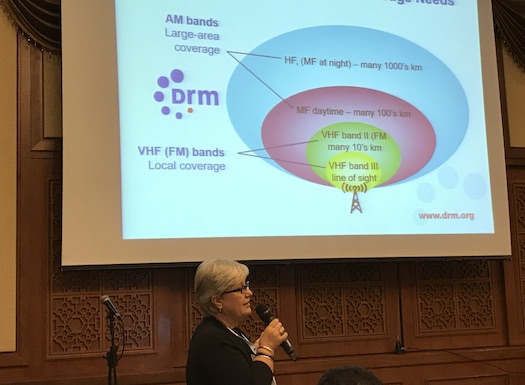Ruxandra Obreja, the Chair of the DRM Consortium, talked about the philosophy of digital radio switchover as part of a series of presentations at DBS2019.
“Don’t focus on the analog switch off date, rather focus on the digital radio launch date,” she advised.
When thinking about switching over from analog to digital radio there are three ways you can do it, according to Obreja:
1. Set a firm date like Norway, or
2. Take the bull by horns when the time is right (UK, Switzerland), or
3. Tackle the bull hard then plan your switchover move, like they are doing in India.
“Radio is a cockroach… you cannot kill it… It is free, convenient, accessible and a community asset,” she said
But radio has to keep up with new technology, which is why digital radio is important. So why choose DRM? There are some good reasons to choose this system according to Obreja:
- It is the only global system which covers all of the bands
- You can use the same frequency as now to deliver up to three program streams
- It has better compression and less energy is used
- There is a whole new ecosystem
- There are 1.5 million cars on Indian roads now with DRM receivers
- The audio quality is excellent
- There are multimedia applications available
- Emergency warnings and automatic tuning
Key ingredients for digital radio success include getting all the stakeholders on board: broadcasters, government, receiver manufacturers, retailers.
Also important is to decide on the technology, embark on coverage planning, and also have clear consistent informative communications of the public.
“Define a common ‘launch date’ not a switch off date. This is the date when all stakeholders can tell the listeners they have more and better services. It concentrates the mind and gets everyone together to work towards that date,” she said.
If you have a modern analog transmitter you can upgrade it to digital, you don’t have to buy a new one.
Digital Radio Mondiale is an open standard, so the DRM Consortium does not take a licence fee. It is a single station operating system, you do not have to share bandwidth with other companies on a multiplex.
There are many uses for DRM, for example Radio New Zealand is using it as a distribution system to deliver clear signals to broadcast partners in the Pacific, who then rebroadcast it on their own local analog stations.
Voice of America is going to launch a DRM shortwave service in the next few months, which will be the first digital shortwave service from America. Cyprus and Oman are also using short wave DRM for transmissions.
China is using DRM on both FM and shortwave to digitise their transmissions. It is a very big country which needs a strong system to cover the whole of the country.
In a workshop session the case study of India's roll out of DRM was outlined.
India has the biggest roll out of DRM, according to Yogendra Pal, the honorary Chair of the DRM India chapter.
There are a lot of areas of India which are not covered by FM, so do not have access to many of the new stations that have been launched. These areas are served only by All India radio AM services.
Over 50% of the 1.3 billion population is dependent only on AM broadcasts. The quality is unreliable, with limited services (often only on per transmitter) and there are no value added services.
All India Radio wanted to improve the quality of its AM coverage. At first the national broadcaster considered FM for these underserved areas, but it was too expensive and the services would still be limited. “FM is also spectrum and energy hungry,” said Pal.
So All India Radio has chosen DRM as a solution. It can reuse the existing technical infrastructure, towers and feeder lines and analog and digital can both be broadcast on the same transmitters for as long as is needed for the population to get digital radio receivers. So analog switchoff is not required, listeners who depend on AM can still hear it for a long time to come.
India’s digitisation plan began in 2007 and has progressed since then.
There are now 35 MW and SW high powered transmitters that are digital. Half the country is covered by digital radio now. It has cost 3 billion Indian Rupees to refit the transmitters.
Journaline also delivers extra text services, without the internet and without payment, so this is an important service for much of the audience which is not well served by mobile and internet technology.
The industry has worked very hard to spread DRM receivers. There are already 1.5 million cars with DRM receivers over the past 2 years.
“The car industry has really supported the introduction of DRM. Hyundai, Maruti Suzuki and Mahindra car makers have all begun fitting DRM receivers into their new cars.
There are also many standalone receivers and demand is building for the stereo receivers which have data screens available, as well as AM and FM reception The Avion radio has dropped its cost by 50% due to the high demand.
The latest range of receivers were demonstrated by Alex Zink.

